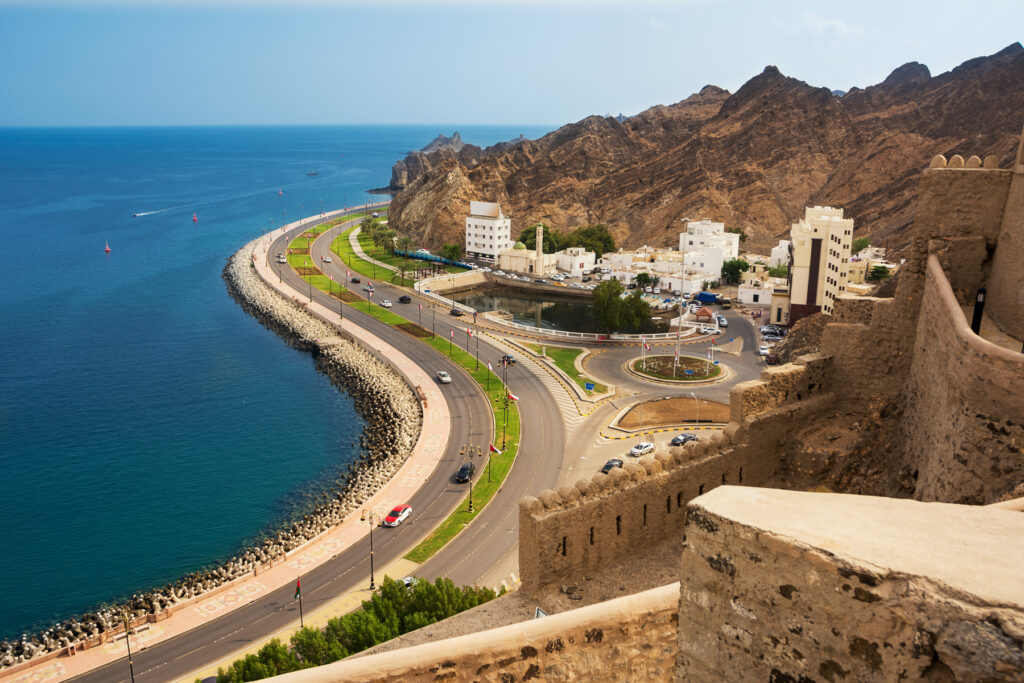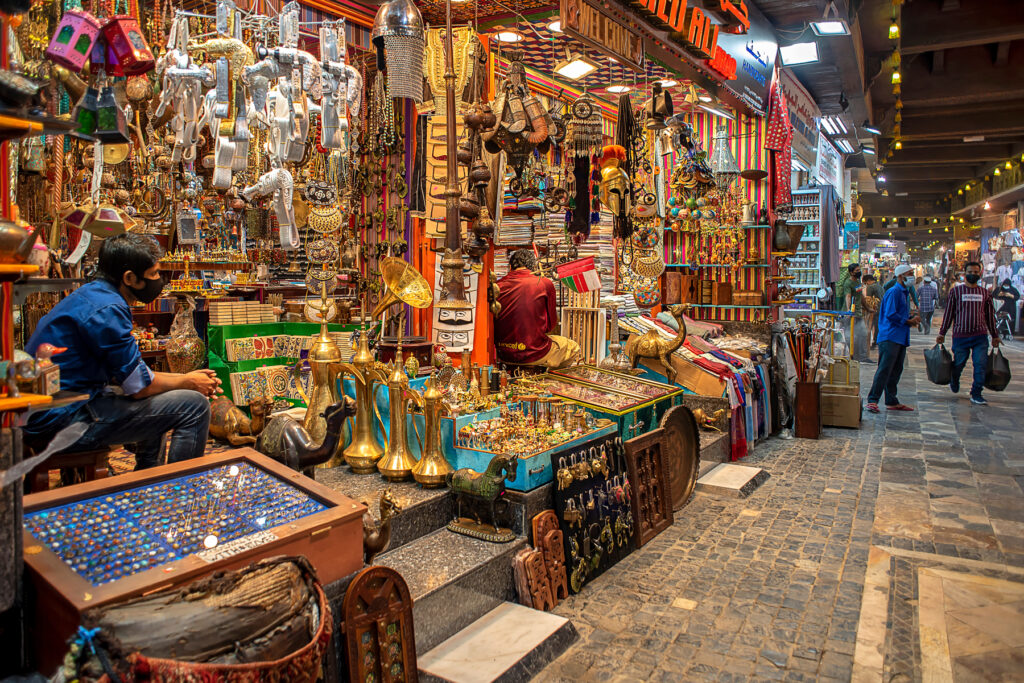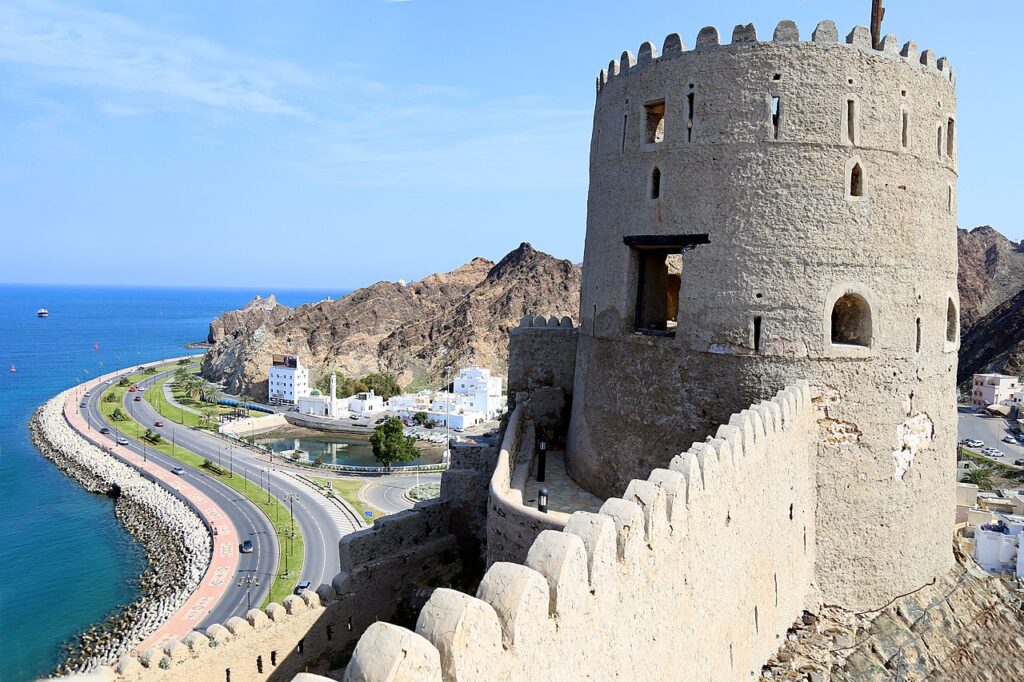Spreading south from its crescent bay towards the chocolate-brown escarpments of the impressive ophiolite hills, Mutrah is the engaging port town that historically served Old Muscat. Despite the nearby harbour of Old Muscat being more sheltered and having a better anchorage, Mutrah’s commercial port became more successful as it was accessible to camel caravans from Oman’s interior.
What to see and do in Mutrah
Fish suq
The most westerly area of the Corniche is the entrance into Mina Sultan Qaboos, where cruise ship passengers exit and enter the port. Here is also the fish suq. This modern, curving building, designed by Snøhetta, was inspired by the flowing style of Arabic calligraphy, though there is a hint of fish scale about its physical construction.
The fish sales area is busiest just after dawn, most notably on Fridays. The variety of fish on offer is extraordinary – various tuna caught in the open seas, grouper caught close to the shores and reef fish including parrotfish, sergeant fish and, of course, sardines. The occasional shark unfortunately also ends up for the chop here; often they are blacktip reef shark.
The Corniche
The walk along Mutrah’s crescent-shaped Corniche is one of the most rewarding walks in Oman, with whitewashed houses overlooked by mountains and forts; in turn, the buildings gaze at the comings and goings of small and large boats and most impressively the sultan’s cream-coloured yachts.

From the fish suq, at the western end where there is some car parking, the walk will take you east towards Old Muscat along a level paved route, though do look out for drainage holes in the paving stones. The walk to Al Alam Palace is under 5km, so allow at least an hour. Highlights will include the two large yachts in the harbour, which are the sultan’s personal boats: Al Said, the principal one (155m long), and Fulk Al Salamah (164m long).
Bait Al Baranda
Occupying an early 20th-century house this small museum takes its name from the open veranda over its entrance, which used to catch sea breezes. The museum’s purpose is to offer a broad overview of Muscat’s geography, history and culture. Several hands-on displays and periodic art exhibitions add interest, though it all could do with some care and attention.
Highlights include interactive explanations of Muscat’s geology and a small costume gallery. Though less comprehensive than Bait Al Zubair museum and the National Museum in Old Muscat, Bait Al Baranda is invariably a less crowded experience than the first and perhaps equally rewarding as a result.
Mutrah Suq
Mutrah Suq (or Suq Al Dhalam – Market of Darkness) is the largest suq in Oman. Though not to the scale of the Grand Bazar of Istanbul, Cairo’s Khan el-Khalili or Soltani Bazar in Isfahan Iran, it is an excellent size to enjoy without getting hopelessly lost. In reality, it is two suqs: the eastern area under the fort is the wholesale market, while the western part is for retail, though today you can wander through and buy from both. The central passageway from the Corniche entrance through to the town entrance to the south is also a wadi (watercourse), which floods during heavy rains. It leads from the Corniche entrance to the southern gate, a stroll of less than 300 metres.
During the winter, when the port is visited by cruise ships, the suq can seem like Alexanderplatz, Corso Buenos Aires or Oxford Street depending on the boat that is in port. Since completion of the modernisation project for the Corniche for the 35th National Day (in 2005), the suq has been adorned with a sea-green glass-domed entrance opposite pedestrian traffic lights; this dome and traffic lights are ideal to orient yourself by. Just outside the suq, on the Corniche, try a fantastic milkshake or fruit juice in the coffee shops.

Suq Al Dhalam takes its name from the darkness provided by the shading over the winding alleys, which are more extensive and complex than anywhere else in the country. As in the 1960s, you can still buy a Taiwanese tricycle, a Mexican gold sovereign, an old bedstead or a Penguin paperback. Today the central passage is increasingly given over to souvenirs or you can buy frankincense sold by men from the mountains of Dhofar.
If you have a yearning for an ‘I love Oman’ T-shirt or belly dancer costume, this is the place to find them. You will also find coffee pots, incense burners, rose-water sprinklers, henna, Arabic coffee, oregano, dried limes, dried chilli peppers, Oman perfumes, the ubiquitous pashminas, dishdashas, antiques, gold, silver, chests, rugs, handicrafts and even the essential animated toy camel.
Mutrah Fort
The fort, in its current form, is three towers connected by a curtain wall which encircles little more than a cannon platform, no more that 10m wide and certainly less than 100m long.

The towers existed during the Portuguese occupation while the curtain wall post-dates that period. Inside are a few old ships’ cannons; and hopefully the toilet is open. However, the attraction, after a climb of 100 or so steps, is the view over the port and Corniche.
Place and People Museum
Immediately below Mutrah Fort is this low, whitewashed house that today is a museum, but not so long ago was a home. Small exhibition rooms include furnishings, ornaments and clothing arranged to give an impression of how a more affluent Omani’s home looked in the mid 20th century. The Place and People Museum has a small art gallery with paintings available for sale and there is a gift shop at the exit.
Riyam Park
Clearly landmarked by the monumental white incense burner that sits atop a cliff, Riyam Park is a reasonably well-maintained park. In the cooler early evening, or on your walk up the original road between Mutrah and Old Muscat, it’s a grassy, peaceful spot to wander around. There is a children’s playground, and snacks and drinks can be bought at a kiosk here.